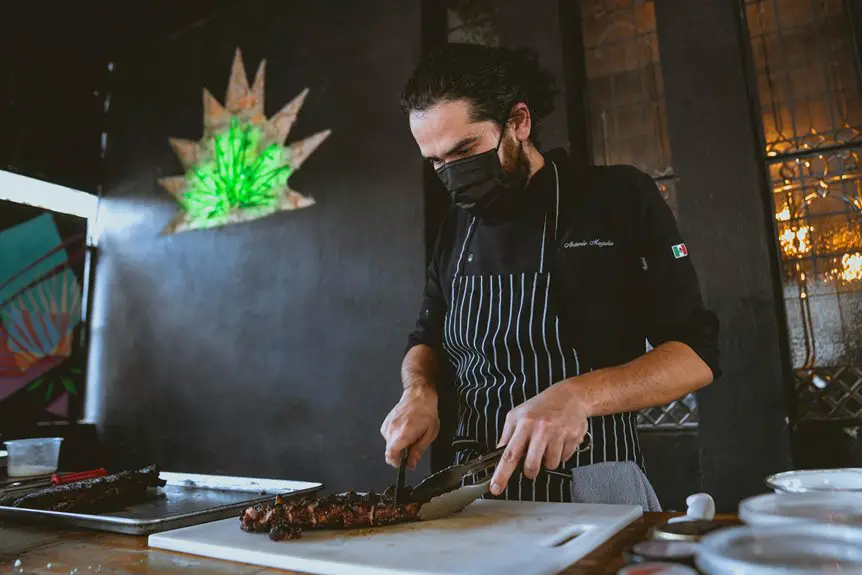You can rely on Kevlar to stop blades effectively because its tightly woven fibers disperse knife impact across a wide area, preventing cuts and punctures. It’s lightweight, flexible, and five times stronger than steel by weight, making it ideal for protective gear like gloves and clothing. While not completely invincible against all blades, Kevlar offers solid defense in many situations. If you want to know how it compares to other materials and what limitations exist, keep exploring further.
Table of Contents
Key Takeaways
- Kevlar’s strong, tightly woven fibers effectively distribute force and resist slicing and puncturing from most common knives.
- Its high tensile strength allows Kevlar to absorb and disperse blade energy, enhancing cut resistance.
- Kevlar gear is tested against various blades, showing solid defense against chef’s knives, utility knives, and serrated edges.
- While Kevlar stops many blades, extremely sharp or serrated knives and repeated strikes can reduce its protective effectiveness.
- Proper maintenance and avoiding harsh conditions are essential to preserve Kevlar’s knife protection capabilities over time.
Understanding Kevlar: Composition and Properties
Kevlar is a synthetic fiber known for its exceptional strength and durability. When you examine Kevlar, you’ll find it’s made from long chains of poly-paraphenylene terephthalamide, a type of aromatic polyamide.
These chains align tightly, creating strong intermolecular bonds that give Kevlar its remarkable tensile strength. You’ll notice Kevlar fibers are lightweight yet five times stronger than steel by weight. This combination allows it to resist impact and stretching without breaking.
Plus, Kevlar has excellent heat resistance, so it won’t melt or degrade easily under high temperatures. You’ll also find it’s flexible, letting it conform to shapes without losing strength.
Understanding these unique properties helps you appreciate why Kevlar is used in various protective gear and industrial applications.
How Kevlar Provides Protection Against Knives
Although knives are designed to cut through tough materials, the unique structure of Kevlar fibers helps stop blades from penetrating. When a knife strikes Kevlar, the tightly woven fibers distribute the force across a wide area, reducing the impact at any single point.
This fiber arrangement creates a strong barrier that resists slicing and puncturing. As you move or strain against a blade, Kevlar’s high tensile strength absorbs and disperses energy, preventing the blade from cutting through.
Additionally, the fibers are incredibly flexible, so they won’t easily snap or tear under pressure, maintaining their protective integrity. This combination of strength and flexibility makes Kevlar an effective shield against knife attacks, giving you reliable protection when you need it most.
Types of Kevlar-Based Protective Gear
When choosing Kevlar-based protection, you’ll find gloves designed for different levels of cut resistance, perfect for handling sharp tools safely.
You can also wear protective clothing made from Kevlar fibers that shield essential areas without sacrificing comfort.
For even stronger defense, composite armor materials combine Kevlar with other substances to boost knife resistance.
Kevlar Gloves Varieties
You’ll find several types of gloves designed to protect your hands from cuts and abrasions, each tailored for different tasks and risk levels.
Kevlar gloves come in lightweight models for dexterity, ideal if you need precision without sacrificing protection. Heavier-duty gloves offer reinforced palm and finger areas, perfect for handling sharp tools or machinery.
Some gloves combine Kevlar with other materials like nitrile or rubber coatings, enhancing grip and resistance to liquids or chemicals. There are also cut-resistant gloves designed for industrial or kitchen use, where blade contact is frequent.
When choosing, consider the glove’s cut rating, flexibility, and comfort to guarantee it fits your specific work environment.
With the right Kevlar gloves, you’ll greatly reduce injury risks while maintaining efficiency.
Protective Clothing Options
Since sharp objects pose constant threats in many environments, choosing the right Kevlar-based protective clothing is essential. You’ll find several types designed to balance flexibility, comfort, and blade resistance. Whether you need arm guards, sleeves, or full body suits, Kevlar gear offers reliable protection without sacrificing mobility.
Here’s a quick look at common Kevlar-based protective clothing options:
| Protective Gear | Best Use Case |
|---|---|
| Kevlar Sleeves | Arm protection during cutting |
| Kevlar Aprons | Front body defense in kitchens |
| Full Kevlar Suits | Heavy-duty industrial settings |
Selecting the right type depends on your specific risk and comfort needs. Always prioritize certified, tested products for effective knife protection.
Composite Armor Materials
Choosing the right Kevlar-based protective clothing is just the start; understanding the composite armor materials behind these products helps you make smarter decisions.
Kevlar often combines with other elements to boost blade resistance. Here are four common composite materials you’ll encounter:
- Kevlar and Steel Plates: Offers rigid protection, ideal for high-risk situations.
- Kevlar and Ceramic Tiles: Lightweight and effective, these absorb and disperse blade impacts.
- Kevlar and UHMWPE (Ultra-High-Molecular-Weight Polyethylene): Provides flexibility with strong cut resistance.
- Kevlar and Carbon Fiber: Combines durability and lightness, perfect for tactical gear.
Knowing these composites helps you pick gear that balances protection, comfort, and weight—ensuring you’re ready against blade threats.
Testing Kevlar’s Effectiveness Against Different Blades
You’ll want to know how Kevlar stands up against various blade types, from sharp knives to serrated edges.
Testing focuses on penetration resistance and how well the material holds up over repeated use.
This helps you understand its real-world durability and protection levels.
Blade Types Tested
We tested Kevlar against five common blade types to see how well it stands up under different cutting forces.
You’ll want to know which blades pose the biggest challenge to Kevlar’s protection. Here’s what we focused on:
- Chef’s Knife – a broad, sharp blade used in everyday cutting.
- Utility Knife – a smaller, pointed blade with a sharp tip.
- Box Cutter – designed for slicing through tough materials with a razor edge.
- Serrated Knife – featuring jagged teeth that saw through surfaces.
Each blade applies pressure differently, testing Kevlar’s flexibility and strength.
By analyzing these, you can understand how Kevlar performs in real-world scenarios where various knives might be involved.
This helps you gauge its reliability for your protection needs.
Penetration Resistance Levels
Although each blade tests Kevlar differently, its penetration resistance levels reveal how well it can truly protect you. Kevlar is designed to absorb and disperse the energy from sharp objects, but its effectiveness varies based on blade type and force. Here’s a quick look at how Kevlar holds up against different blades:
| Blade Type | Penetration Depth | Protection Level |
|---|---|---|
| Straight Knife | 1-3 mm | High |
| Serrated Knife | 2-5 mm | Moderate |
| Stiletto | 4-7 mm | Lower |
Understanding these levels helps you choose the right Kevlar protection for your needs. Keep in mind, sharper or more pointed blades can challenge Kevlar more, but overall, it offers solid defense against most common threats.
Durability Over Time
As Kevlar endures repeated impacts from various blades, its fibers gradually wear down, which can reduce its protective capabilities over time.
You need to evaluate how durability affects safety when relying on Kevlar for knife protection. Here’s what you should keep in mind:
- Blade Type – Serrated blades cause more fiber damage than straight edges.
- Impact Frequency – More hits mean faster degradation of Kevlar’s strength.
- Maintenance – Proper care, like avoiding moisture, extends Kevlar’s life.
- Layer Count – Multiple Kevlar layers improve durability against repeated strikes.
Limitations and Vulnerabilities of Kevlar Knife Protection
While Kevlar offers impressive resistance against many types of cuts, it doesn’t make you invincible to all knife attacks. You should know that Kevlar fibers can be compromised by extremely sharp or serrated blades, especially if the force behind the strike is high.
Repeated strikes in the same spot can also weaken its protective capability, reducing effectiveness. Additionally, Kevlar’s performance diminishes if it gets wet or is exposed to harsh chemicals, which can degrade the fibers over time.
It’s not designed to stop stabbing or puncture attacks as effectively as slashing cuts because knives can penetrate between the woven fibers.
Comparing Kevlar With Other Cut-Resistant Materials
Understanding Kevlar’s limitations helps highlight why other cut-resistant materials might sometimes be a better fit depending on your needs.
When you compare Kevlar to alternatives, consider these factors:
- Dyneema – Offers superior cut resistance and is lighter than Kevlar, ideal for mobility.
- Spectra – Similar to Dyneema, it provides excellent cut protection with high strength-to-weight ratio.
- Steel Mesh – Extremely durable against blades but heavier and less flexible than Kevlar.
- Chainmail – Offers outstanding cut resistance but limits dexterity and comfort.
Each material has trade-offs in weight, flexibility, and protection level.
Real-World Applications and User Experiences
When you rely on Kevlar for knife protection, real-world experiences reveal how its balance of flexibility and strength performs under pressure.
Workers in kitchens, construction sites, and law enforcement often share how Kevlar gloves and sleeves protect them from accidental cuts without restricting movement.
You’ll find users appreciate Kevlar’s lightweight feel, allowing them to stay agile while staying safe.
However, some report that prolonged exposure to sharp blades can eventually wear down the fibers, so it’s essential to monitor the gear’s condition regularly.
Overall, Kevlar’s proven effectiveness in practical settings makes it a trusted choice for those needing reliable cut resistance.
You’ll benefit most when choosing gear designed specifically for your tasks and handling it with care during use.
Maintenance and Care for Kevlar Protective Equipment
Because Kevlar gear undergoes heavy use in demanding environments, you need to maintain it properly to guarantee lasting protection.
Kevlar gear faces tough conditions, so proper maintenance is essential for reliable, long-lasting protection.
Neglecting care can reduce its blade resistance and durability. Follow these key steps:
- Clean regularly: Use mild soap and cold water; avoid harsh chemicals that can degrade fibers.
- Air dry only: Keep your Kevlar gear away from direct heat or sunlight to prevent fiber damage.
- Inspect frequently: Look for tears, punctures, or fraying that could compromise protection.
- Store properly: Keep it in a cool, dry place away from heavy objects that might deform the material.
Choosing the Right Kevlar Gear for Your Needs
Proper maintenance keeps your Kevlar gear reliable, but selecting the right equipment from the start plays a big role in how well it protects you. Consider the level of protection you need, the gear’s weight, and comfort to guarantee you’re wearing something practical and effective.
| Gear Type | Best For |
|---|---|
| Kevlar Gloves | Handling knives or sharp tools |
| Kevlar Vest | Torso protection in risky jobs |
| Kevlar Sleeves | Arm protection during cutting |
Match your gear to your tasks. If you handle blades regularly, gloves or sleeves might be your best bet. For more thorough coverage, a vest offers solid torso defense. Always prioritize fit and flexibility to stay safe without sacrificing mobility.
Frequently Asked Questions
Can Kevlar Protection Be Customized for Specific Blade Types?
Did you know Kevlar can stop blades with up to 90% efficiency? You can customize it for specific blade types by adjusting weave density and layering, ensuring your protection is tailored to your exact cutting threats.
How Does Kevlar Perform in Extreme Weather Conditions?
You’ll find Kevlar performs well in extreme weather, staying strong in cold and heat. It resists moisture and maintains durability, so you won’t worry about it weakening or losing protection when conditions get tough.
Is Kevlar Protection Effective Against Blunt Force Trauma?
You’ll find Kevlar offers decent blunt force trauma protection, but it’s not foolproof. While it absorbs impact energy, severe blows can still cause injury. Pairing it with padding improves overall protection considerably.
What Is the Average Lifespan of Kevlar Protective Gear?
You can expect Kevlar protective gear to last around 3 to 5 years with regular use. Its lifespan depends on exposure to elements, wear, and proper care, so always inspect your gear before relying on it.
Are There Eco-Friendly Alternatives to Kevlar for Knife Protection?
You’ll find eco-friendly alternatives to Kevlar, like hemp and flax fibers, that offer strong knife protection. These materials aren’t just green; they hold up like a fortress, blending sustainability with safety effectively.
- Does Chiffon Fabric Stink - July 15, 2025
- Does Chiffon Fabric Affect the Economy - July 15, 2025
- Does Cotton Fabric Have a Nap - July 15, 2025







